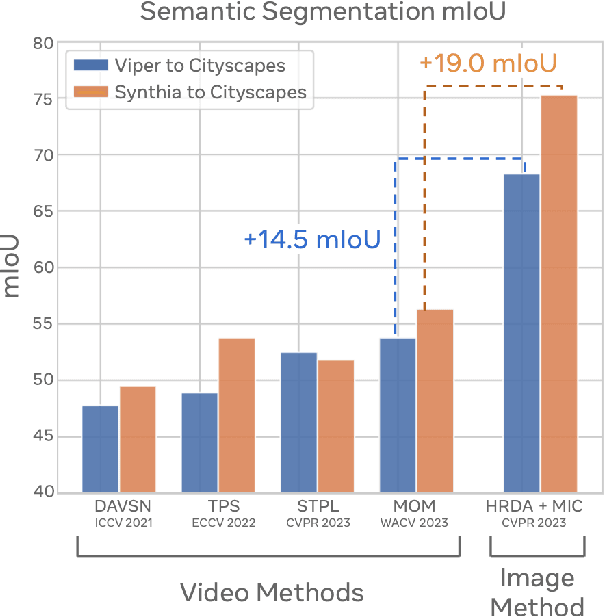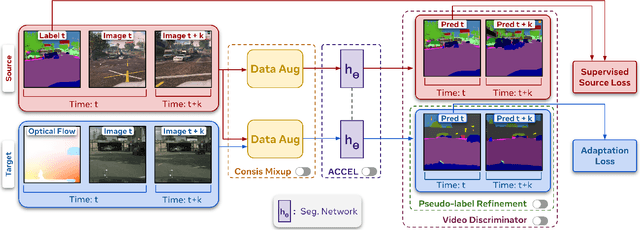Viraj Prabhu
Trust but Verify: Programmatic VLM Evaluation in the Wild
Oct 17, 2024Abstract:Vision-Language Models (VLMs) often generate plausible but incorrect responses to visual queries. However, reliably quantifying the effect of such hallucinations in free-form responses to open-ended queries is challenging as it requires visually verifying each claim within the response. We propose Programmatic VLM Evaluation (PROVE), a new benchmarking paradigm for evaluating VLM responses to open-ended queries. To construct PROVE, we provide a large language model (LLM) with a high-fidelity scene-graph representation constructed from a hyper-detailed image caption, and prompt it to generate diverse question-answer (QA) pairs, as well as programs that can be executed over the scene graph object to verify each QA pair. We thus construct a benchmark of 10.5k challenging but visually grounded QA pairs. Next, to evaluate free-form model responses to queries in PROVE, we propose a programmatic evaluation strategy that measures both the helpfulness and truthfulness of a response within a unified scene graph-based framework. We benchmark the helpfulness-truthfulness trade-offs of a range of VLMs on PROVE, finding that very few are in-fact able to achieve a good balance between the two. Project page: \url{https://prove-explorer.netlify.app/}.
xGen-MM (BLIP-3): A Family of Open Large Multimodal Models
Aug 16, 2024



Abstract:This report introduces xGen-MM (also known as BLIP-3), a framework for developing Large Multimodal Models (LMMs). The framework comprises meticulously curated datasets, a training recipe, model architectures, and a resulting suite of LMMs. xGen-MM, short for xGen-MultiModal, expands the Salesforce xGen initiative on foundation AI models. Our models undergo rigorous evaluation across a range of tasks, including both single and multi-image benchmarks. Our pre-trained base model exhibits strong in-context learning capabilities and the instruction-tuned model demonstrates competitive performance among open-source LMMs with similar model sizes. In addition, we introduce a safety-tuned model with DPO, aiming to mitigate harmful behaviors such as hallucinations and improve safety. We open-source our models, curated large-scale datasets, and our fine-tuning codebase to facilitate further advancements in LMM research. Associated resources will be available on our project page above.
We're Not Using Videos Effectively: An Updated Domain Adaptive Video Segmentation Baseline
Feb 06, 2024



Abstract:There has been abundant work in unsupervised domain adaptation for semantic segmentation (DAS) seeking to adapt a model trained on images from a labeled source domain to an unlabeled target domain. While the vast majority of prior work has studied this as a frame-level Image-DAS problem, a few Video-DAS works have sought to additionally leverage the temporal signal present in adjacent frames. However, Video-DAS works have historically studied a distinct set of benchmarks from Image-DAS, with minimal cross-benchmarking. In this work, we address this gap. Surprisingly, we find that (1) even after carefully controlling for data and model architecture, state-of-the-art Image-DAS methods (HRDA and HRDA+MIC) outperform Video-DAS methods on established Video-DAS benchmarks (+14.5 mIoU on Viper$\rightarrow$CityscapesSeq, +19.0 mIoU on Synthia$\rightarrow$CityscapesSeq), and (2) naive combinations of Image-DAS and Video-DAS techniques only lead to marginal improvements across datasets. To avoid siloed progress between Image-DAS and Video-DAS, we open-source our codebase with support for a comprehensive set of Video-DAS and Image-DAS methods on a common benchmark. Code available at https://github.com/SimarKareer/UnifiedVideoDA
AUGCAL: Improving Sim2Real Adaptation by Uncertainty Calibration on Augmented Synthetic Images
Dec 19, 2023Abstract:Synthetic data (SIM) drawn from simulators have emerged as a popular alternative for training models where acquiring annotated real-world images is difficult. However, transferring models trained on synthetic images to real-world applications can be challenging due to appearance disparities. A commonly employed solution to counter this SIM2REAL gap is unsupervised domain adaptation, where models are trained using labeled SIM data and unlabeled REAL data. Mispredictions made by such SIM2REAL adapted models are often associated with miscalibration - stemming from overconfident predictions on real data. In this paper, we introduce AUGCAL, a simple training-time patch for unsupervised adaptation that improves SIM2REAL adapted models by - (1) reducing overall miscalibration, (2) reducing overconfidence in incorrect predictions and (3) improving confidence score reliability by better guiding misclassification detection - all while retaining or improving SIM2REAL performance. Given a base SIM2REAL adaptation algorithm, at training time, AUGCAL involves replacing vanilla SIM images with strongly augmented views (AUG intervention) and additionally optimizing for a training time calibration loss on augmented SIM predictions (CAL intervention). We motivate AUGCAL using a brief analytical justification of how to reduce miscalibration on unlabeled REAL data. Through our experiments, we empirically show the efficacy of AUGCAL across multiple adaptation methods, backbones, tasks and shifts.
Battle of the Backbones: A Large-Scale Comparison of Pretrained Models across Computer Vision Tasks
Nov 20, 2023



Abstract:Neural network based computer vision systems are typically built on a backbone, a pretrained or randomly initialized feature extractor. Several years ago, the default option was an ImageNet-trained convolutional neural network. However, the recent past has seen the emergence of countless backbones pretrained using various algorithms and datasets. While this abundance of choice has led to performance increases for a range of systems, it is difficult for practitioners to make informed decisions about which backbone to choose. Battle of the Backbones (BoB) makes this choice easier by benchmarking a diverse suite of pretrained models, including vision-language models, those trained via self-supervised learning, and the Stable Diffusion backbone, across a diverse set of computer vision tasks ranging from classification to object detection to OOD generalization and more. Furthermore, BoB sheds light on promising directions for the research community to advance computer vision by illuminating strengths and weakness of existing approaches through a comprehensive analysis conducted on more than 1500 training runs. While vision transformers (ViTs) and self-supervised learning (SSL) are increasingly popular, we find that convolutional neural networks pretrained in a supervised fashion on large training sets still perform best on most tasks among the models we consider. Moreover, in apples-to-apples comparisons on the same architectures and similarly sized pretraining datasets, we find that SSL backbones are highly competitive, indicating that future works should perform SSL pretraining with advanced architectures and larger pretraining datasets. We release the raw results of our experiments along with code that allows researchers to put their own backbones through the gauntlet here: https://github.com/hsouri/Battle-of-the-Backbones
FACTS: First Amplify Correlations and Then Slice to Discover Bias
Sep 29, 2023



Abstract:Computer vision datasets frequently contain spurious correlations between task-relevant labels and (easy to learn) latent task-irrelevant attributes (e.g. context). Models trained on such datasets learn "shortcuts" and underperform on bias-conflicting slices of data where the correlation does not hold. In this work, we study the problem of identifying such slices to inform downstream bias mitigation strategies. We propose First Amplify Correlations and Then Slice to Discover Bias (FACTS), wherein we first amplify correlations to fit a simple bias-aligned hypothesis via strongly regularized empirical risk minimization. Next, we perform correlation-aware slicing via mixture modeling in bias-aligned feature space to discover underperforming data slices that capture distinct correlations. Despite its simplicity, our method considerably improves over prior work (by as much as 35% precision@10) in correlation bias identification across a range of diverse evaluation settings. Our code is available at: https://github.com/yvsriram/FACTS.
ICON$^2$: Reliably Benchmarking Predictive Inequity in Object Detection
Jun 07, 2023Abstract:As computer vision systems are being increasingly deployed at scale in high-stakes applications like autonomous driving, concerns about social bias in these systems are rising. Analysis of fairness in real-world vision systems, such as object detection in driving scenes, has been limited to observing predictive inequity across attributes such as pedestrian skin tone, and lacks a consistent methodology to disentangle the role of confounding variables e.g. does my model perform worse for a certain skin tone, or are such scenes in my dataset more challenging due to occlusion and crowds? In this work, we introduce ICON$^2$, a framework for robustly answering this question. ICON$^2$ leverages prior knowledge on the deficiencies of object detection systems to identify performance discrepancies across sub-populations, compute correlations between these potential confounders and a given sensitive attribute, and control for the most likely confounders to obtain a more reliable estimate of model bias. Using our approach, we conduct an in-depth study on the performance of object detection with respect to income from the BDD100K driving dataset, revealing useful insights.
LANCE: Stress-testing Visual Models by Generating Language-guided Counterfactual Images
May 30, 2023Abstract:We propose an automated algorithm to stress-test a trained visual model by generating language-guided counterfactual test images (LANCE). Our method leverages recent progress in large language modeling and text-based image editing to augment an IID test set with a suite of diverse, realistic, and challenging test images without altering model weights. We benchmark the performance of a diverse set of pretrained models on our generated data and observe significant and consistent performance drops. We further analyze model sensitivity across different types of edits, and demonstrate its applicability at surfacing previously unknown class-level model biases in ImageNet.
Bridging the Sim2Real gap with CARE: Supervised Detection Adaptation with Conditional Alignment and Reweighting
Feb 09, 2023



Abstract:Sim2Real domain adaptation (DA) research focuses on the constrained setting of adapting from a labeled synthetic source domain to an unlabeled or sparsely labeled real target domain. However, for high-stakes applications (e.g. autonomous driving), it is common to have a modest amount of human-labeled real data in addition to plentiful auto-labeled source data (e.g. from a driving simulator). We study this setting of supervised sim2real DA applied to 2D object detection. We propose Domain Translation via Conditional Alignment and Reweighting (CARE) a novel algorithm that systematically exploits target labels to explicitly close the sim2real appearance and content gaps. We present an analytical justification of our algorithm and demonstrate strong gains over competing methods on standard benchmarks.
Mitigating Bias in Visual Transformers via Targeted Alignment
Feb 08, 2023Abstract:As transformer architectures become increasingly prevalent in computer vision, it is critical to understand their fairness implications. We perform the first study of the fairness of transformers applied to computer vision and benchmark several bias mitigation approaches from prior work. We visualize the feature space of the transformer self-attention modules and discover that a significant portion of the bias is encoded in the query matrix. With this knowledge, we propose TADeT, a targeted alignment strategy for debiasing transformers that aims to discover and remove bias primarily from query matrix features. We measure performance using Balanced Accuracy and Standard Accuracy, and fairness using Equalized Odds and Balanced Accuracy Difference. TADeT consistently leads to improved fairness over prior work on multiple attribute prediction tasks on the CelebA dataset, without compromising performance.
 Add to Chrome
Add to Chrome Add to Firefox
Add to Firefox Add to Edge
Add to Edge